Chapter 3
A Concrete Example of a Model for Describing Audiovisual Content
3.1. Introduction
In Chapter 1 (section 1.6), we briefly outlined the theoretical framework of reference which guides us in creating the metalinguistic resources needed to put in place the models of description* an analyst needs in order to carry out the description of the content of an audiovisual corpus. The question which now arises is how that theoretical reference model is actually reflected in the aforementioned models of description making up the metalanguage of description* of an archive’s universe of discourse*. More concretely still, how is this framework of reference expressed in such-and-such an interactive working form which is part of the interface of the ASW Studio, presented briefly in Chapter 2 (also see [STO 11a])?
In this chapter, we shall present and discuss a model of description* of the content of an audiovisual text or corpus. In the next chapter (Chapter 4), we shall draw a number of more general consequences from this, for the approach developed herein of analyzing the content of corpora or entire audiovisual texts.
section 3.2 very briefly presents a library* of models of description for analyzing audiovisual corpora making up a particular archive. In section 3.3, we shall present and discuss the sequences* which make up a model of description. A sequence is a thematically and functionally circumscribed configuration which defines a specific stage of description in the process of analyzing an audiovisual text using a model of description.
Then, in section 3.4, we shall see that each sequence which makes up a model of description forms part of a particular type of sequence answering to a specific field of analysis. Finally, section 3.5 is given over to a very brief presentation of the canonic internal organization of a sequence of description. As we shall see, each sequence is necessarily made up of two types of schemas of definition* – one defining the object of analysis*, the other the procedure of analysis*.
3.2. Selecting the appropriate model from the library of descriptive models of description of audiovisual content
To begin with, we shall discuss the concrete example of a model of thematic description* which we use to carry out an analysis of the content of audiovisual texts.
Take the example of identification and description of audiovisual sources which speak about Native South American civilizations such as the Aztec civilization, the Inca civilization, the Chavín civilization or indeed the Mapuche civilization. A corpus of audiovisual texts dealing with this type of subject is part of the Culture Crossroads Archives1 (CCA).
The CCA archives (like all the other archives created using the ASW working environment outlined briefly in Chapter 2 of this book, and in a far more detailed manner in [STO 11a]) have a library* of models of description of audiovisual content – a library which defines the metalanguage of description of an archive’s universe of discourse*. In other words, it defines the relevant domains of knowledge (in accordance with the archive’s policy, its mission or missions) of the audiovisual texts which make up the archive.
In our case, the library of models of description defines the universe of discourse of the CCA archives. As Figure 3.1 shows, the CCA’s library of models of description of audiovisual content is presented in the form of a structured list of model titles such as: Intangible cultural heritage, Cultural constructs by country, etc. Certain titles refer to collections of models, others to a specific model.
Figure 3.1 shows us that the CCA’s library of models of description contains a specific model entitled Subject “Civilizations in America”. The model in question forms part of a specialized collection of models of thematic description of audiovisual corpora dealing with civilizations of the world and their cultural constructs.
Figure 3.1. Part of the library of models of thematic description of the universe of discourse of the CCA – Culture Crossroads Archive
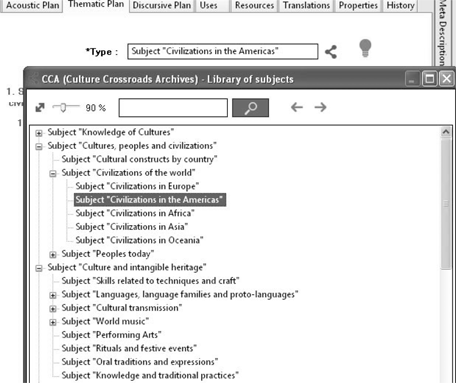
Of course, this collection of models can also be found – exactly as it is, in part or having undergone certain modifications/adaptations – in libraries of models of description defining the universe of discourse of other (digital) audiovisual archives.
Thus, in the context of the ASW-HSS Project, the collection Civilizations of the world is found as it is but with certain simplified functionality (notably, the deletion of the functional part, “discourse analysis”, see below) in the library of models of the FMSH-ARA audiovisual archives devoted to broadcasting the scientific events staged by the Fondation Maison des Sciences de l’Homme (FMSH)2 in Paris. It is also found in part in the library of models of thematic description defining the audiovisual archives AICH3, devoted to Andean intangible cultural heritage (see [LEG 11a]). “In part” here means that only the model relating to South American civilizations (with a referential restriction to Andean civilizations) is found in the library of the AICH archives.
Figure 3.2. The description sequence reserved for the referential domain thematized in an audiovisual text or corpus
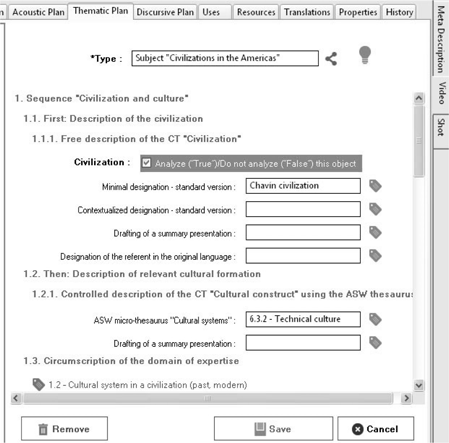
Figure 3.3. The description sequence reserved for geographically contextualizing the referential object of an analysis
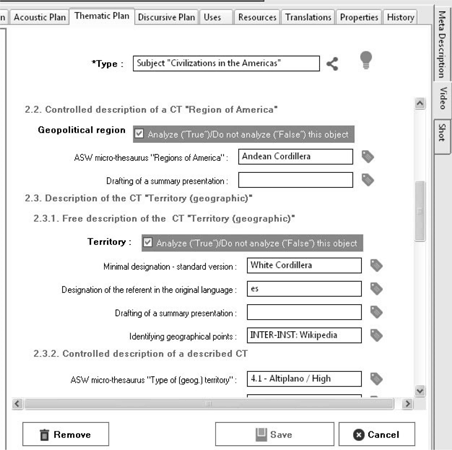
In any case, if the analyst selects the title Subject “Civilizations in America”, an interface opens in the guise of an interactive working form which invites him to carry out a description of an audiovisual text in accordance with the logic of the selected model.
3.3. The sequences in a model of content description
Thus, by selecting the title Subject “Civilizations in America”, the analyst accesses an interactive form which is his working interface for carrying out an analysis of audiovisual corpora whose content refers to a civilization – be it contemporary or historical – on American soil.
Figure 3.4. The description sequence reserved for contextualizing the referential object of an analysis, by country and by administrative territory
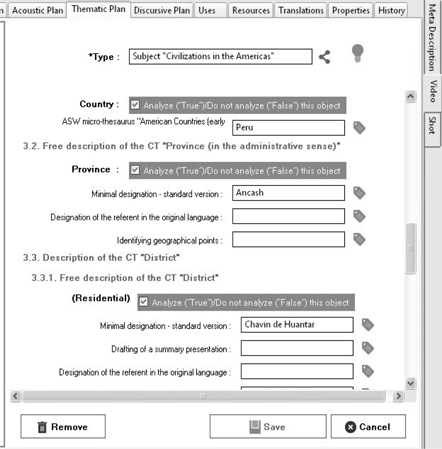
Thus, Figure 3.2 shows a first sequence* of the model which has specialized functionality in referential analysis, i.e. in analysis of the domain of knowledge which is thematized in an audiovisual text or corpus. In our case, the sequence relates to two types of objects* specific to the domain of reference in question. These are the type of objects designated by the conceptual term* [Civilization] and the type of objects designated by the conceptual term* [Cultural construct].4 Other sequences of the same type may be more elaborate, and may include many more types of objects. Our sequence has a simple internal structure and is useful only for rudimentary analyses but which suffices in the context, e.g. of basic thematic indexations of large audiovisual corpora.
Figure 3.5. The description sequence reserved for temporally contextualizing the referential object of the analysis
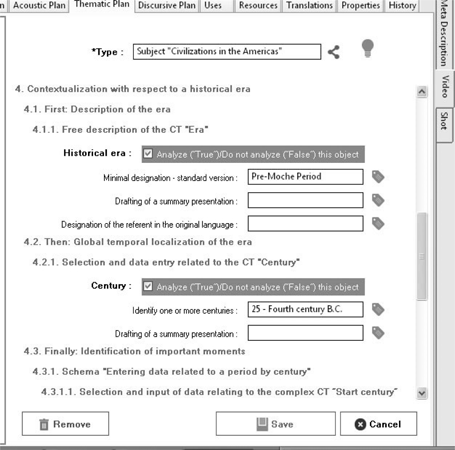
Figures 3.3, 3.4 and 3.5 show three description sequences which all have the same functionality specialization: that of spatially or temporally locating the domain of reference thematized in an audiovisual text. Finally, Figure 3.6 shows two more sequences which are functionally and thematically different: two sequences which allow us, on the one hand, to carry out an analysis of the discourse production from a domain of knowledge dealt with in an audiovisual text and, on the other hand, to explicitize the analyst’s perspective as regards the domain of knowledge and/or the discourse production in the text being analyzed.
In Chapter 16, we shall give a more detailed discussion on the constitution and organization of a library of functionally specialized sequences*. Here, let us merely raise the following two points:
– every model of description* (of audiovisual content) is made up of one or more sequences*;
– every sequence belongs to a category of sequences, functionally specialized in performing a specific analysis of the audiovisual content.
3.4. Field of description and sequential organization of an analytical form
Looking at Figures 3.2–Figures 3.6, it emerges that the form in question is structured into four main fields of analysis:
1) The sequence Description of a civilization and its culture (Figure 3.2) corresponds to the principal and necessary field of identification and explicitation of the domain or object of reference. In general, this sequence is part of a specific type of sequences reserved for the analytical task entitled Description of the knowledge object being thematized. Thus, Figure 3.2 shows the sequence which has the specialized functionality in referential analysis and which, thematically, relates to two types of objects specific to the domain of reference in question. These are the type of objects designated by the conceptual term [Civilization] and the type of objects designated by the conceptual term [Cultural construct].
2) The sequences Geographic location in the Americas (Figure 3.3), Precise location in a country in the Americas (Figure 3.4) and Dating by century (Figure 3.5) correspond to the field of the spatial (geographic) and temporal (historic) location of the domain or object of reference in question. They form part of a specific type of sequences given over to the task of Contextualization of the knowledge object being thematized (task 1.2 in Figure 4.4; see section 4.5).
3) The sequence Analysis of the discourse held on the civilization (Figure 3.6) corresponds to the field reserved for the description of certain enunciative aspects and the discourse production from the domain dealt with (focus of interest, viewpoint from which object is examined, etc.). This forms part of the type of specific sequences reserved for task 2 (in Figure 4.4; see section 4.5), Analysis of discourse production from the topic.
Figure 3.6. The description sequence reserved for the analysis of the held discourse
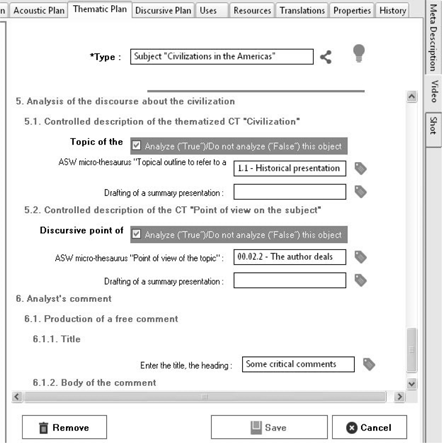
4) Finally, the sequence Analyst’s comments (Figure 3.6) corresponds to the meta-textual field which allows the analyst to comment either on his own work or on the treatment of the object in the video or segment being analyzed. Once again, it forms part of a specific type of sequences reserved for the task of explicitizing the context of the analysis of the topic and its objectives (task 4 in Figure 4.4; see section 4.6).
Let us stress here that only work in the first field, that of identification and explicitation of the referential object of the analysis, is obligatory and necessarily presupposed for work in the other three fields – location of the referential object, analysis of the discourse production from the referential object being thematized and, finally, the meta-textual field.
In summary, and simply, these four fields of analysis enable us to answer the basic questions necessary for any content analysis – questions which we have already discussed in Chapter 1 (section 1.6):
1. What? What is being spoken about? Where? and When? Where, and at what moment in time/era is the object being spoken about located?
2. How? How is the object treated and developed in the audiovisual text?
3. In what form? What are the verbal and/or audiovisual expressions used to “speak” about the object?
4.Why? Why have I chosen this topic to discuss? For what motives? With what intentions in mind?
A model of thematic description may, of course, be complemented by other functional fields of analysis which either enrich the four fields cited above or which open the doors to analysis of new issues not taken into consideration by our four fields. In any case, every interactive working form making up the interface between the analyst and a model of description must take account of the four fields which characterize the domain of expertise of the content of an audiovisual text or corpus:
– the objects of the domain of knowledge to which the text refers and which constitute its topical structure (strictly speaking);
– the discourse production and discursive development of the knowledge objects;
– the verbal, audiovisual or other (gestural, spatial, etc.) expression of the knowledge objects thematized and developed in the form of discourse in a text;
– the analyst’s viewpoint (his interest, his understanding, etc.) either in relation to the knowledge objects thematized in the text or in relation to the discourse production from the knowledge objects, or indeed in relation to both aspects.
By integrating these four fields of analysis as systematically as possible in a model of thematic description of an audiovisual corpus, we can better take account of the fact that any thematization of a knowledge object in a text is performed according to a discursive mediation plan, i.e. according to the author’s point of view and his capability to hierarchize, formulate and develop (in a linear manner) his point of view as regards the object dealt with in a discourse or a text.
3.5. The level of schemas of definition and procedures of description
The sequence of a model of description is necessarily made up of one or more schemas of definition*. A schema of definition is a configuration of conceptual terms which is set apart:
– either in schemas defining the objects of analysis* (such as [Civilization] or [Cultural construct]);
– or in schemas defining the activities of analysis* (such as [Minimal designation (of an object)], [Illustration (of an object)], etc.).
Thus, the act of description or analysis is regulated at the level of the schemas of definition in the form of “instructions” or implicit “directives” of the type:
a) first, select the type or types of objects to be analyzed,
b) then carry out the analysis, opting for this-or-that activity.
Let us specify that a particular task of description (referential description, description of the space-time context, description of the discourse production, etc.) is always carried out according to precise procedures of description which include one or a selection of objects of analysis. In particular, we distinguish between two main procedures:
1. free description* (it is the analyst who determines the values of a conceptual term);
2. and controlled description* (the analyst relies on a thesaurus to determine the value or values of a conceptual term).
Thus, as Figure 3.2 demonstrates, the referential description* of the knowledge object [Civilization] is done using a procedure of free description. It is the analyst who enters the nominal expression <Chavín civilization> to denote the specific value of the conceptual term [Civilization] in the context of his analysis of an audiovisual text thematizing “something” about this pre-Colombian civilization from around 2,500 years ago.
On the other hand, the referential description of the knowledge object [Cultural construct (of the civilization in question)] is carried out using a procedure of controlled description, i.e. using a thesaurus specialized in the particular domain of cultural expertise. In order to assign a specific value to the conceptual term [Cultural construct (in relation to Chavín civilization)], the analyst uses (in our case) the ASW micro-thesaurus “Types/genres of cultural systems” and selects the descriptor <Technical culture> thereby indicating that the audiovisual text he is analyzing deals with the technical culture of the Chavín civilization. We shall discuss the procedures of free and controlled description in greater detail in Chapters 9 and 10.
1 http://semiolive.ext.msh-paris.fr/arc/.
2 These archives constitute one of the experimentation workshops of the ASW-HSS Project. They cover a corpus of hundreds of hours of recorded interviews and scientific events (such as conferences, research seminars, etc.) in human and social sciences – a corpus which we built-up with our collaborators at ESCoM over the course of several years, thanks to European and French R&D projects, a specific budget from the Ministry of Higher Education and Research and, finally, logistical and financial support from the Fondation itself. This program to constitute a body of heritage definitely came to an end in 2009, but the corpus collected still forms an interesting field for experimentation in audiovisual semiotics. To visit the experimentation portal of the FMSH-AAR (FMSH-ARA), entirely funded by the ANR as part of the ASW-HSS Project, see: http://semiolive.ext.msh-paris.fr/msh-aar/.
3 The URL of the PCIA archive (Patrimoine Culturel Immatériel Andin – AICH in English) is: http://semiolive.ext.msh-paris.fr/pcia/.
4 We shall come back later to the problem of conceptual terms* which actually constitute the vocabulary of the ASW metalanguage (see Chapter 4 and Part Four of this book). Let us simply note here that in terms of notation, a conceptual term is placed between two square brackets as follows: [Conceptual term]. The value of that conceptual term (its instance, its occurrence or indeed its predefined expression in a thesaurus) is expressed graphically as follows: <Value of the conceptual term> or indeed [Conceptual term: <Value of the conceptual term>].
